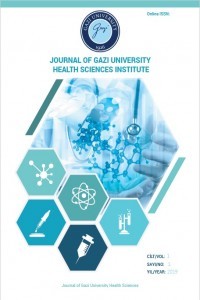Autism and Vitamin D
Autism and Vitamin D
Autism, Vitamin D, Biochemistry,
___
- American Psychiatric Association.(2013). Diagnostic and Statistical Manual of Mental Disorders. 5th ed.DSM-5 Washington, DC, 50-59.
- Biçer AH, Alsaffar AA. (2016). Dietary intake and physical activity levels of male adolescents with autism spectrum disorder ASD and normal to high body mass index BMI A case series study. Research in Autism Spectrum Disorders. 31,1-10.
- Cannel JJ. (2017). Vitamin D and autism, what's new?. Reviews in Endocrine and Metabolic Disorders, 18,183–193. Ding HT, Taur Y, Walkup JT. (2017). Gut Microbiota and Autism: Key Concepts and Findings. J Autism Dev Disord, 47(2), 480-489.
- Feng J, Shan L, Du L, Wang B, Li H, Wang W, Wang T, Dong H, Yue X, Xu Z.(2017). Clinical improvement following vitamin D3 supplementation in autism Spectrum disorder. Nutritional Neuroscience.20(5):284–290.
- Fernell E, Bejerot S, Westerlund J, Miniscalco C, Simila H, Eyles D, Gillberg C, Humble MB.(2015). Autism spectrum disorder and low vitamin D at birth: a sibling control study. Molecular Autism,6:3.
- Ford TC, Nibbs R, Crewther DP.(2017). Glutamate/GABA+ ratio is associated with the psychosocial domain of autistic and schizotypal traits. PLoS One. 2017; 12(7): e0181961.
- Gevi F, Zolla L, Gabriele S, Persico A.M. (2016). Urinary metabolomics of young Italian autistic children supports abnormal tryptophan and purine metabolism. Molecular Autism, 7(47), 2-11.
- Görmez V, Örengül AC, Baljinnyam S, Aliyeva N.(2017). Diagnostic and demographic characteristics of patients referred to a child and adolescent psychiatry clinic.. Journal of Mood Disorders, 7(1), 41-46.
- Gvozdjakova A, Kucharska J, Ostatnikova D, Babinska K, Nakladal D, Crane F L.(2014). Ubiquinol Improves Symptoms in Children with Autism. Oxidative Medicine and Cellular Longevity, 1-5.
- Howsmon DP, Kruger U, Melnyk S, James S J, Hahn J. (2017). Classification and adaptive behavior prediction of children with autism spectrum disorder based upon multivariate data analysis of markers of oxidative stress and DNA methylation. PLOS Computational Biology, 13(3), 1-15.
- Ibrahim SH, Voigt RG, Katusic SK, Weaver AL, Barbaresi WJ. (2009). Incidence of gastrointestinal symptoms in children with autism: a population-based study. Pediatrics, 680-686.
- Levy M, Levy K, Hoff D, Conklın J.(2010). Vagus nerve stimulation therapy in patients with autism spectrum disorder and intractable epilepsy: results from the vagus nerve stimulation therapy patient outcome registry. J Neurosurg Pediatrics, 5, 595-602.
- Lintas C, Persico AM. (2009). Autistic phenotypes and genetic testing: state-of-the-art for the clinical geneticist. J Med Genet, 46(1),1-8.
- Liu Z, Que S, Xu J, Peng T. (2014). Alanine aminotransferase-old biomarker and new concept: a review.İnternational Journal Of Medical Science, 11(9),925-935.
- Loomes R, Hull L, Mandy WPL.( 2017). What Is the Male-to-Female Ratio in Autism Spectrum Disorder? A Systematic Review and Meta-Analysis. J Am Acad Child Adolesc Psychiatry. 2017 Jun;56(6):466-474. doi: 10.1016/j.jaac.2017.03.013. Máčová L, Bıčíková M, Ostatníková D, Hıll M, Stárka L.(2017). Vitamin D, Neurosteroids and Autism. Physiological Research, 26(66), 333-340.
- Mazahery H, Conlon CA, Beck KL, Mugridge O, Kruger MC, Stonehouse W, Camargo CA, Meyer BJ, Jones B, Hurst PR. (2019). A randomised controlled trial of vitamin D and omega-3 long chain polyunsaturated fatty acids in the treatment of irritability and hyperactivity among children with autism spectrum disorder. J Steroid Biochem Mol Biol,187,9-16.
- Newell C, Bomhof M.R, Reimer RA, Hittel DS, Rho JM, Shearer J.(2016). Ketogenic diet modifies the gut microbiota in a murine model of autism spectrum disorder. Molecular Autism, 7(37), 1-6.
- Nogay N, Nelms M. (2019). Can we reduce autism-related gastrointestinal and behavior problems by gut microbiota based dietary modulation?. Nutritional Neuroscience, DOI: 10.1080/1028415X.2019.1630894.
- Rossignol DA, Frye RE.(2012). Mitochondrial dysfunction in autism spectrum disorders: a systematic review and metaanalysis. Molecular Psychiatry, 17(3), 290–314.
- Sathe N, Andrews JC, McPheeters ML, Warren ZE. (2017). Nutritional and Dietary Interventions for Autism Spectrum Disorder: A Systematic Review. Pediatrics. 2017 Jun;139(6). doi: 10.1542/peds.2017-0346.
- Sevim, S., Ayaz, A.,(2017). Are B12 Vitamins Effective İn The Treatment Of Autistic Children?. H.Ü. The Journal Of The Faculty Of Health Scıences, 4(1), 15.
- Sherman KE. (1991). Alanine aminotransferase in clinical practice: a review. Archives of internal medicine. 1991;151(2):260. Stubbs EG, Cheng K. (2005). Autism Spectrum Disorders. K. Cheng, K.M. Myers (Ed.). Child and Adolescent Psychiatry ,227-246.
- Tseng P, Cheng, Y., Chenc, Y., Stubbs, B., Whiteley, P., Carvalho, A.F., Lii, D., Chenk, T., Yang, W., Tang, C., Chun, C., Yang, W., Liang, H., Wua, C., Yenr, C., Lint,P. (2018). Peripheral iron levels in children with autism spectrum disorders vs controls: a systematic review and meta-analysis. Nutrition Research, 50,45.
- Volkmar FR, Pauls D. (2003). Autism. Lancet 2003, 362 (9390) 1133-1141.
- Zhang J, Zhang JX, Zhang QL.(2016). PI3K/AKT/mTOR-mediated autophagy in the development of autism spectrum disorder. Brain Research Bulletin, 2016 Jul;125:152-8. doi: 10,1016/j.
- ISSN: 2687-6353
- Yayın Aralığı: Yılda 3 Sayı
- Başlangıç: 2019
- Yayıncı: Gazi Üniversitesi
Dental Sensitivity in Adult and Pediatric Patients
Guarana and Its Possible Effects on Health
Ayfer BEYAZ COŞKUN, Nevin ŞANLIER
The Effects of Acyl and Desacyl Forms of The Ghrelin Hormone on The Body
Emine ELİBOL, Yasemin AKDEVELİOĞLU
Hale GÖK DAĞIDIR, Neslihan BUKAN, Ebru ARHAN, Nazrin TOMBUL, Burak ARSLAN, Esra ÜLGEN TEMEL
Hypericum perforatum Releasing From Silver Sulphadiozine Loaded Sodium Alginate Membranes
